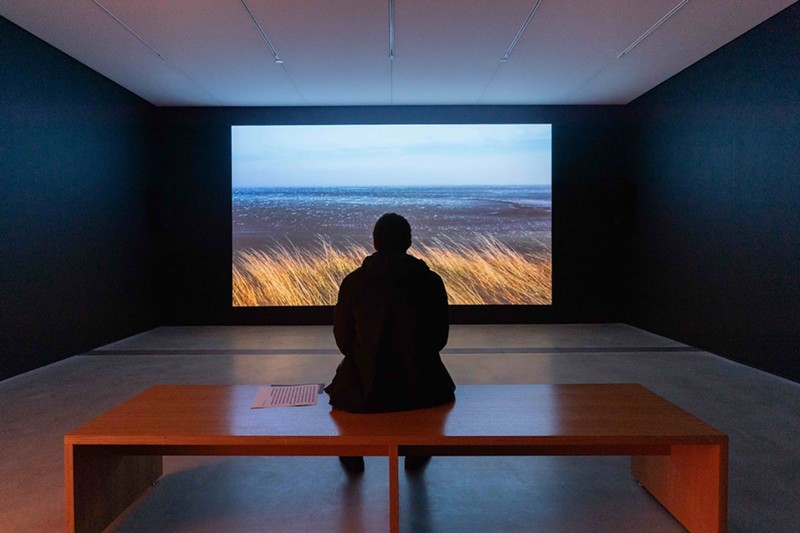
If humankind and Mother Nature are in a long-term relationship, then humans are akin to an emotionally unavailable, exploitative partner who hasn’t planned a date in decades yet still expects their long-suffering counterpart to put dinner on the table every evening at seven sharp. So often we treat the natural world as a commodity at our disposal rather than a life-sustaining force with which our fate is intertwined.
We’re feeling the effects of our neglect now. Last month, for example, St. Louis saw the warmest February day in recorded history. In this moment, it’s critical that we reflect on our relationship to the Earth — and how our actions shape the land we inhabit — in order to salvage it. The Pulitzer Arts Foundation’s new spring exhibition, On Earth, provides an opportunity to do just that.
On Earth features a labyrinth of immersive videos and films that meditate on the impact of humans’ destructive tendencies but also celebrate moments of exaltation and empowerment that arise through our connection with the environment. From feelings of joy and reverence to environmental devastation and displacement, each work draws parallels between our treatment of the Earth and the people who inhabit it.
The artist roster pulls from various corners of the globe, spanning from Colorado to Lebanon to Brazil and beyond, and includes Ali Cherri, Jeffrey Gibson, Sky Hopinka, Ana Mendieta and Rivane Neuenschwander. Representing perspectives from a diverse range of geographies was intentional and crucial, emphasizes Stephanie Weissberg, curator at the Pulitzer.
“When you’re talking about humans’ relationship to the Earth, it feels very limiting to locate that within a specific country or cultural perspective,” she says. “The show is not about identifying differences between places. In many ways, there is more in common in these videos than there is not.”
Cleverly located in the museum’s lower level, On Earth inspires a sensation of literal and metaphorical proximity to the Earth as visitors descend the Pulitzer’s massive stairway toward the dimly lit, cave-like theater rooms that await them. There, visitors begin their earthly odyssey with Mnemonics of Shape and Reason, a four-minute video crafted by Sky Hopinka, an experimental filmmaker and member of the Ho-Chunk Nation whose work features vibrantly colored imagery, Indigenous perspectives, and sites of ancestral significance.
Mnemonics of Shape and Reason begins with a scene filmed from inside a moving car traveling down a remote road in a mountainous desert landscape. The scene quickly transforms, however, as an alternate, upside-down landscape appears and merges with the original. Hopinka effectively blurs the boundaries between natural and man-made environments, pushing back on colonial notions of territory and borders. The next four minutes are a hypnotic and near-psychedelic experience where sky, earth, water and fauna flow together in visually altered fragments. At one point, we see human figures walking amongst the clouds. Through this kaleidoscopic journey, Hopinka underscores the interconnectedness of all living beings, a theme that permeates the exhibition.
Other featured works, such as Ali Cherri’s Of Men and Gods and Mud, foster conversation about environmental catastrophes and population displacement. Set in northern Sudan, the documentary centers brickmakers as they work with mud at a factory near the Merowe Dam. The dam, one of Africa's largest hydroelectric projects, has resulted in the displacement of more than 50,000 people. Against this backdrop, English and Arabic narrations reference origin myths that describe clay as the primordial material for the human body. By juxtaposing ancient narratives with contemporary realities, Cherri invites reflection on how we interact with life-giving materials and occasionally harness them for destructive purposes.
In contrast, Jeffrey Gibson’s To Feel Myself Beloved on the Earth highlights social movements and Black and queer empowerment in conjunction with natural environments.
Gibson’s 16-minute video was produced in 2020 amidst the initial stages of the pandemic and civil unrest stemming from systemic violence against Black and queer people. It features solo dancers moving through urban and natural environments, as well as live performances by vocalists and drummers playing rhythms from the African diaspora paired with recordings from a Black Trans Lives march in New York, where Gibson is based. The work addresses painful experiences, but it also emphasizes pride, exuberance, and resilience in the face of adversity.
“The show isn’t meant to drill down into the doom of the present moment. It also looks at the balance of the way things are,” says Weissberg. “People are still finding ways to be empowered and celebrate their relationship to the Earth and also use it to imagine new futures.”
On Earth is accompanied by an equally stunning and provocative exhibit on the museum’s main floor titled Interwoven. This exhibition showcases the first comprehensive collection spanning Colombian artist Delcy Morelos’ 30-plus-year career.
All exhibits will be open at the Pulitzer Arts Foundation (3716 Washington Boulevard) through August 4 and are free to attend. The museum is open 10 a.m. through 5 p.m. Thursday through Sunday. For more info, visit pulitzerarts.org.
Subscribe to Riverfront Times newsletters.
Follow us: Apple News | Google News | NewsBreak | Reddit | Instagram | Facebook | Twitter | Or sign up for our RSS Feed









